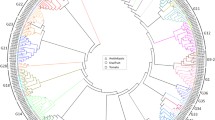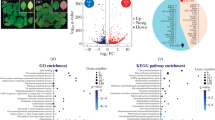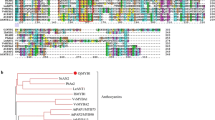Abstract
Anthocyanins are important for fruits as they contribute not only to fruit color but also to human health. Anthocyanin biosynthesis is transcriptionally regulated by the MYB–bHLH–WD40 transcription complex. For Chinese bayberry (Myrica rubra), the MYB and bHLH regulating anthocyanin accumulation, named as MrMYB1 and MrbHLH1, respectively, have been isolated previously. In this study, by searching and assembling the sequences available in the RNA-Seq database of Chinese bayberry, 60 WD40 members were obtained. Through phylogenetic analysis of these members with those related to anthocyanin biosynthesis regulation in other plants, unigenes 803 and 11128, designated as MrWD40-1 and MrWD40-2, respectively, have been isolated as the putative WD40 members regulating anthocyanin biosynthesis. However, positive correlation was observed between the anthocyanin accumulation and the expression patterns of MrWD40-1 but not MrWD40-2, both during fruit development, and in different tissues or cultivars of Chinese bayberry. Tobacco transient assays indicated that the ternary expression of MrMYB1–MrbHLH1–MrWD40-1 induced anthocyanin accumulation earlier and stronger than with binary expression of MrMYB1–MrbHLH1 in the absence of MrWD40-1. Compared with the enhancement effect on anthocyanin biosynthesis of MrWD40-1, MrWD40-2 could not improve the anthocyanin accumulation even with MrMYB1 and MrbHLH1, although the highly conserved four WD repeat motifs were also present in MrWD40-2. Moreover, it was observed that MrWD40-1 physically interacted with both MrMYB1 and MrbHLH1 according to yeast two-hybrid analysis. These results indicated that MrWD40-1, but not MrWD40-2, is the member regulating anthocyanin biosynthesis in Chinese bayberry through the formation of a ternary complex with MrMYB1 and MrbHLH1.






Similar content being viewed by others
References
An X-H, Tian Y, Chen K-Q, Wang X-F, Hao Y-J (2012) The apple WD40 protein MdTTG1 interacts with bHLH but not MYB proteins to regulate anthocyanin accumulation. J Plant Physiol 169(7):710–717. doi:10.1016/j.jplph.2012.01.015
Baudry A, Heim MA, Dubreucq B, Caboche M, Weisshaar B, Lepiniec L (2004) TT2, TT8, and TTG1 synergistically specify the expression of BANYULS and proanthocyanidin biosynthesis in Arabidopsis thaliana. Plant J 39(3):366–380. doi:10.1111/j.1365-313X.2004.02138.x
Ben-Simhon Z, Judeinstein S, Nadler-Hassar T, Trainin T, Bar-Ya’akov I, Borochov-Neori H, Holland D (2011) A pomegranate (Punica granatum L.) WD40-repeat gene is a functional homologue of Arabidopsis TTG1 and is involved in the regulation of anthocyanin biosynthesis during pomegranate fruit development. Planta 234(5):865–881. doi:10.1007/s00425-011-1438-4
Besseau S, Li J, Palva ET (2012) WRKY54 and WRKY70 co-operate as negative regulators of leaf senescence in Arabidopsis thaliana. J Exp Bot 63(7):2667–2679. doi:10.1093/jxb/err450
Bjerkan KN, Jung-Roméo S, Jürgens G, Genschik P, Grini PE (2012) Arabidopsis WD repeat domain55 interacts with DNA damaged binding protein1 and is required for apical patterning in the embryo. Plant Cell 24(3):1013–1033. doi:10.1105/tpc.111.089425
Brueggemann J, Weisshaar B, Sagasser M (2010) A WD40-repeat gene from Malus × domestica is a functional homologue of Arabidopsis thaliana TRANSPARENT TESTA GLABRA1. Plant Cell Rep 29(3):285–294. doi:10.1007/s00299-010-0821-0
Butelli E, Licciardello C, Zhang Y, Liu J, Mackay S, Bailey P, Reforgiato-Recupero G, Martin C (2012) Retrotransposons control fruit-specific, cold-dependent accumulation of anthocyanins in blood oranges. Plant Cell 24(3):1242–1255. doi:10.1105/tpc.111.095232
Carey CC, Strahle JT, Selinger DA, Chandler VL (2004) Mutations in the pale aleurone color1 regulatory gene of the Zea mays anthocyanin pathway have distinct phenotypes relative to the functionally similar TRANSPARENT TESTA GLABRA1 gene in Arabidopsis thaliana. Plant Cell 16(2):450–464. doi:10.1105/tpc.018796
Chen K-S, Xu C-J, Zhang B, Ferguson IB (2004) Red bayberry: botany and horticulture. In: Horticultural reviews. John Wiley & Sons, New York, pp 83–114. doi:10.1002/9780470650837.ch3
de Vetten N, Quattrocchio F, Mol J, Koes R (1997) The an11 locus controlling flower pigmentation in petunia encodes a novel WD-repeat protein conserved in yeast, plants, and animals. Gene Dev 11(11):1422–1434. doi:10.1101/gad.11.11.1422
Espley RV, Hellens RP, Putterill J, Stevenson DE, Kutty-Amma S, Allan AC (2007) Red colouration in apple fruit is due to the activity of the MYB transcription factor, MdMYB10. Plant J 49(3):414–427. doi:10.1111/j.1365-313X.2006.02964.x
Feng S, Wang Y, Yang S, Xu Y, Chen X (2010) Anthocyanin biosynthesis in pears is regulated by a R2R3-MYB transcription factor PyMYB10. Planta 232(1):245–255. doi:10.1007/s00425-010-1170-5
Feng C, Chen M, Xu C-J, Bai L, Yin X-R, Li X, Allan AC, Ferguson IB, Chen K-S (2012) Transcriptomic analysis of Chinese bayberry (Myrica rubra) fruit development and ripening using RNA-Seq. BMC Genomics 13(1):19. doi:10.1186/1471-2164-13-19
Gao X, Chen Z, Zhang J, Li X, Chen G, Li X, Wu C (2012) OsLIS-L1 encoding a lissencephaly type-1-like protein with WD40 repeats is required for plant height and male gametophyte formation in rice. Planta 235(4):713–727. doi:10.1007/s00425-011-1532-7
Grotewold E, Sainz MB, Tagliani L, Hernandez JM, Bowen B, Chandler VL (2000) Identification of the residues in the Myb domain of maize C1 that specify the interaction with the bHLH cofactor R. Proc Natl Acad Sci USA 97(25):13579–13584. doi:10.1073/pnas.250379897
Hichri I, Barrieu F, Bogs J, Kappel C, Delrot S, Lauvergeat V (2011) Recent advances in the transcriptional regulation of the flavonoid biosynthetic pathway. J Exp Bot 62(8):2465–2483. doi:10.1093/jxb/erq442
Huang Y-J, Song S, Allan AC, Liu X-F, Yin X-R, Xu C-J, Chen K-S (2013) Differential activation of anthocyanin biosynthesis in Arabidopsis and tobacco over-expressing an R2R3 MYB from Chinese bayberry. Plant Cell Tissue Organ Cult. doi:10.1007/s11240-013-0291-5
Koes R, Verweij W, Quattrocchio F (2005) Flavonoids: a colorful model for the regulation and evolution of biochemical pathways. Trends Plant Sci 10(5):236–242. doi:10.1016/j.tplants.2005.03.002
Lee S, Lee J, Paek K-H, Kwon S-Y, Cho H, Kim S, Park J (2010) A novel WD40 protein, BnSWD1, is involved in salt stress in Brassica napus. Plant Biotechnol Rep 4(2):165–172. doi:10.1007/s11816-010-0131-6
Matus JT, Loyola R, Vega A, Peña-Neira A, Bordeu E, Arce-Johnson P, Alcalde JA (2009) Post-veraison sunlight exposure induces MYB-mediated transcriptional regulation of anthocyanin and flavonol synthesis in berry skins of Vitis vinifera. J Exp Bot 60(3):853–867. doi:10.1093/jxb/ern336
Matus JT, Poupin MJ, Cañón P, Bordeu E, Alcalde JA, Arce-Johnson P (2010) Isolation of WDR and bHLH genes related to flavonoid synthesis in grapevine (Vitis vinifera L.). Plant Mol Biol 72(6):607–620. doi:10.1007/s11103-010-9597-4
Neer EJ, Schmidt CJ, Nambudripad R, Smith TF (1994) The ancient regulatory-protein family of WD-repeat proteins. Nature 371(6495):297–300. doi:10.1038/371297a0
Niu S-S, Xu C-J, Zhang W-S, Zhang B, Li X, Lin-Wang K, Ferguson IB, Allan AC, Chen K-S (2010) Coordinated regulation of anthocyanin biosynthesis in Chinese bayberry (Myrica rubra) fruit by a R2R3 MYB transcription factor. Planta 231(4):887–899. doi:10.1007/s00425-009-1095-z
Ouyang Y, Huang X, Lu Z, Yao J (2012) Genomic survey, expression profile and co-expression network analysis of OsWD40 family in rice. BMC Genomics 13(1):100. doi:10.1186/1471-2164-13-100
Palapol Y, Ketsa S, Lin-Wang K, Ferguson IB, Allan AC (2009) A MYB transcription factor regulates anthocyanin biosynthesis in mangosteen (Garcinia mangostana L.) fruit during ripening. Planta 229(6):1323–1334. doi:10.1007/s00425-009-0917-3
Pang Y, Wenger JP, Saathoff K, Peel GJ, Wen J, Huhman D, Allen SN, Tang Y, Cheng X, Tadege M, Ratet P, Mysore KS, Sumner LW, Marks MD, Dixon RA (2009) A WD40 repeat protein from Medicago truncatula is necessary for tissue-specific anthocyanin and proanthocyanidin biosynthesis but not for trichome development. Plant Physiol 151(3):1114–1129. doi:10.1104/pp. 109.144022
Petroni K, Tonelli C (2011) Recent advances on the regulation of anthocyanin synthesis in reproductive organs. Plant Sci 181(3):219–229. doi:10.1016/j.plantsci.2011.05.009
Schaart JG, Dubos C, Romero De La Fuente I, van Houwelingen AMML, de Vos RCH, Jonker HH, Xu W, Routaboul J-M, Lepiniec L, Bovy AG (2013) Identification and characterization of MYB–bHLH–WD40 regulatory complexes controlling proanthocyanidin biosynthesis in strawberry (Fragaria × ananassa) fruits. New Phytol 197(2):454–467. doi:10.1111/nph.12017
Shan L-L, Li X, Wang P, Cai C, Zhang B, Sun C-D, Zhang W-S, Xu C-J, Ferguson IB, Chen K-S (2008) Characterization of cDNAs associated with lignification and their expression profiles in loquat fruit with different lignin accumulation. Planta 227(6):1243–1254. doi:10.1007/s00425-008-0696-2
Smith TF, Gaitatzes C, Saxena K, Neer EJ (1999) The WD repeat: a common architecture for diverse functions. Trends Biochem Sci 24(5):181–185. doi:10.1016/S0968-0004(99)01384-5
Sompornpailin K, Makita Y, Yamazaki M, Saito K (2002) A WD-repeat-containing putative regulatory protein in anthocyanin biosynthesis in Perilla frutescens. Plant Mol Biol 50(3):485–495. doi:10.1023/a:1019850921627
Sun C-D, Zhang B, Zhang J-K, Xu C-J, Wu Y-L, Li X, Chen K-S (2012a) Cyanidin-3-glucoside-rich extract from Chinese bayberry fruit protects pancreatic β cells and ameliorates hyperglycemia in streptozotocin-induced diabetic mice. J Med Food 15:288–298. doi:10.1089/jmf.2011.1806
Sun C-D, Zheng Y-X, Chen Q-J, Tang X-L, Jiang M, Zhang J-K, Li X, Chen K-S (2012b) Purification and anti-tumour activity of cyanidin-3-O-glucoside from Chinese bayberry fruit. Food Chem 131(4):1287–1294. doi:10.1016/j.foodchem.2011.09.121
Sun C-D, Huang H-Z, Xu C-J, Li X, Chen K-S (2013) Biological activities of extracts from Chinese bayberry (Myrica rubra Sieb. et Zucc.): a review. Plant Foods Hum Nutr. doi:10.1007/s11130-013-0349-x
Takos AM, Jaffé FW, Jacob SR, Bogs J, Robinson SP, Walker AR (2006) Light-induced expression of a MYB gene regulates anthocyanin biosynthesis in red apples. Plant Physiol 142(3):1216–1232. doi:10.1104/pp. 106.088104
Tamura K, Peterson D, Peterson N, Stecher G, Nei M, Kumar S (2011) MEGA5: molecular evolutionary genetics analysis using maximum likelihood, evolutionary distance, and maximum parsimony methods. Mol Biol Evol 28(10):2731–2739. doi:10.1093/molbev/msr121
Tanaka Y, Sasaki N, Ohmiya A (2008) Biosynthesis of plant pigments: anthocyanins, betalains and carotenoids. Plant J 54(4):733–749. doi:10.1111/j.1365-313X.2008.03447.x
Thompson JD, Gibson TJ, Plewniak F, Jeanmougin F, Higgins DG (1997) The CLUSTAL_X windows interface: flexible strategies for multiple sequence alignment aided by quality analysis tools. Nucleic Acids Res 25(24):4876–4882. doi:10.1093/nar/25.24.4876
van Nocker S, Ludwig P (2003) The WD-repeat protein superfamily in Arabidopsis: conservation and divergence in structure and function. BMC Genomics 4(1):50. doi:10.1186/1471-2164-4-50
Walker AR, Davison PA, Bolognesi-Winfield AC, James CM, Srinivasan N, Blundell TL, Esch JJ, Marks MD, Gray JC (1999) The TRANSPARENT TESTA GLABRA1 locus, which regulates trichome differentiation and anthocyanin biosynthesis in Arabidopsis, encodes a WD40 repeat protein. Plant Cell 11(7):1337–1349. doi:10.1105/tpc.11.7.1337
Wei Y-Z, Hu F-C, Hu G-B, Li X-J, Huang X-M, Wang H-C (2011) Differential expression of anthocyanin biosynthetic genes in relation to anthocyanin accumulation in the pericarp of Litchi Chinensis Sonn. PLoS One 6(4):e19455. doi:10.1371/journal.pone.0019455
Yin X-R, Chen K-S, Allan AC, Wu R-M, Zhang B, Lallu N, Ferguson IB (2008) Ethylene-induced modulation of genes associated with the ethylene signalling pathway in ripening kiwifruit. J Exp Bot 59(8):2097–2108. doi:10.1093/jxb/ern067
Zhang W-S, Li X, Zheng J-T, Wang G-Y, Sun C-D, Ferguson IB, Chen K-S (2008) Bioactive components and antioxidant capacity of Chinese bayberry (Myrica rubra Sieb. and Zucc.) fruit in relation to fruit maturity and postharvest storage. Eur Food Res Technol 227(4):1091–1097. doi:10.1007/s00217-008-0824-z
Acknowledgments
We thank Prof. Don Grierson from the University of Nottingham (UK) for his kind discussion, suggestion, and efforts in language editing. This research was supported by the National High Technology Research and Development Program of China [2013AA102606], the National Natural Science Foundation of China [31071781], the Program of International Science and Technology Cooperation [2011DFB31580], the Special Scientific Research Fund of Agricultural Public Welfare Profession of China (201203089).
Author information
Authors and Affiliations
Corresponding author
Electronic Supplementary Material
Below is the link to the electronic supplementary material.
Fig. S1
Phylogenetic analysis of MrWD40-2 and other WD40 members in planta was carried out with MEGA 5.0. Two WD40 genes of Chinese bayberry are marked with black dots, while the genes ID of those from other species are as follows: AtLWD2 (Arabidopsis thaliana, AEE77190.1), InWDR2 (Ipomoea nil, AB232780.1), VvWDR2 (Vitis vinifera, ABF66626.2), AtAN11 (A. thaliana, AAC18912.1), AtLWD1 (A. thaliana, AEE28948.1) (PDF 104 kb)
Rights and permissions
About this article
Cite this article
Liu, X., Feng, C., Zhang, M. et al. The MrWD40-1 Gene of Chinese Bayberry (Myrica rubra) Interacts with MYB and bHLH to Enhance Anthocyanin Accumulation. Plant Mol Biol Rep 31, 1474–1484 (2013). https://doi.org/10.1007/s11105-013-0621-0
Published:
Issue Date:
DOI: https://doi.org/10.1007/s11105-013-0621-0




